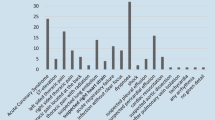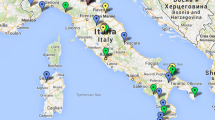Abstract
Background and aims
Targeted ultrasound examinations with portable ultrasound device (handheld ultrasound system [HHUS]) have been defined as “echoscopy” by the European Federation of Societies of Ultrasound in Medicine and Biology (EFSUMB). For abdominal diseases it has been shown that echoscopy is sensitive and specific. The aim of this study is to show that the use of HHUS for abdominal ultrasonography is possible under the conditions prevailing in emergency and intensive care medicine and that it is not inferior to high-end devices (high-end ultrasound systems [HEUS]).
Methods
Examinations were carried out with a first-generation Vscan™ (GE Medical Systems, Solingen, Germany) and HEUS device (Siemens Acuson X‑300 or X‑700, Siemens Healthcare, Erlangen, Germany). The HEUS device was seen as standard. The examinations were randomized and blinded and carried out by two examiners within 30 min in order to avoid falsifications due to time delay. They took place in the intensive care unit, the emergency room and the emergency medical service. The results had to be recorded in an examination sheet.
Results
In all, 86 patients (54 men and 32 women, aged 73 ± 14.58 [28–95] years) were included. In 45.35% (39/86) of the ultrasound examinations using HEUS and in 41.86% (36/89) of the cases using HHUS the examination conditions were optimal. Furthermore, 76.19% of the examinations were carried out by both examiners in the same scanning position. For the detection of liver tumours, HHUS shows a sensitivity of 70% and specificity of 100%. With regard to identifying signs of cholecystitis, i.e., evidence of surrounding inflammation (a) or hydrops (b), HHUS shows a sensitivity of 66.67% (a) and 60% (b) and a specificity of 97.06% (a) and 96.86% (b). The diagnosis of an ileus is successful with a sensitivity of 87.5% and a specificity of 60%. The respiratory variability of the inferior vena cava has a sensitivity of 100% and a specificity of 40% using HHUS. Ascites and pleural effusions can be diagnosed with a sensitivity of 89% and a specificity of 93.1%. When using the FAST (Focused Assessment with Sonography for Trauma) protocol, HHUS has a sensitivity of 80% and a specificity of 90.9%. With the exception of kidney cysts and inferior vena cava, the measurement of the diameter has a positive correlation.
Conclusion
Echoscopy of the abdomen in emergency and intensive care medicine is possible despite restrictive circumstances. The inferior vena cava can only be assessed to a limited extent with the first generation of Vscan™. In order to use sonography in emergency and intensive care medicine, a standardized procedure is to be aimed for and training in emergency sonography is necessary.
Zusammenfassung
Hintergrund und Ziele
Gezielte Ultraschalluntersuchungen mit einem portablen Ultraschallgerät („handheld ultrasound system“ [HHUS]) wurden von der European Federation of Societies of Ultrasound in Medicine and Biology (EFSUMB) als „Echoskopie“ definiert. Für abdominelle Erkrankungen wurde gezeigt, dass die Echoskopie sensitiv und spezifisch ist. Ziel der Studie ist es zu zeigen, dass der Einsatz von Handultraschallgeräten zur Abdomensonographie unter den in der Notfall- und Intensivmedizin herrschenden Bedingungen möglich und dabei High-End-Geräten („high-end ultrasound systems“ [HEUS]) gegenüber nicht unterlegen ist.
Methoden
Die Untersuchungen wurden mit einem Vscan™-Handultraschallgerät (GE Medical Systems, Solingen, Deutschland) der ersten Generation und einem High-end-Ultraschallgerät (Siemens Acuson X‑300 oder X‑700, Siemens Healthcare, Erlangen, Deutschland) durchgeführt. Das High-end-Ultraschallgerät wurde dabei als Standard angesehen. Die Untersuchungen wurden randomisiert und verblindet. Um Verfälschungen durch Zeitverzögerung zu vermeiden, erfolgten die Aufnahmen innerhalb von 30 min durch 2 Untersucher. Die Untersuchungen fanden auf der Intensivstation, in der Notaufnahme und im Rettungsdienst statt. Die Ergebnisse mussten in einem Untersuchungsbogen festgehalten werden.
Ergebnisse
Es wurden 86 Patienten eingeschlossen (54 männlich, 32 weiblich; mittleres Alter 73; 73 ± 14,58 [28–95] Jahre). In 45,35 % (39/86) der Ultraschalluntersuchungen mit dem HEUS waren die Untersuchungsbedingungen optimal und in 41,86 % (36/86), wenn das HHUS zur Anwendung kam. Insgesamt 76,19 % (48/63) der Untersuchungen wurden von beiden Untersuchern in der gleichen Pateintenposition durchgeführt. In der Leber wurden mit HHUS Tumoren mit einer Sensitivität von 70 % und einer Spezifität von 100 % diagnostiziert. Für Zeichen einer Cholezystitis, d. h. entzündliche Umgebungsreaktionen (a) und Gallenblasenhydrops (b), liegt die Sensitivität von HHUS bei 66,67 % (a) respektive 60 % (b), die Spezifität beträgt 97,06 % (a) bzw. 96,86 % (b). Die Diagnose eines Ileus gelingt mit einer Sensitivität von 87,5 % und einer Spezifität von 60 %. Zur Untersuchung der Atemvariabilität der Vena cava inferior weist HHUS eine Sensitivität von 100 % und eine Spezifität von 40 % auf. Aszites und Pleuraergüsse können für HHUS mit einer Sensitivität von 89 % und einer Spezifität von 93,1 % diagnostiziert werden. In der Anwendung des FAST-Protokolls (Focused Assessment with Sonography for Trauma) hat HHUS eine Sensitivität von 80 % und eine Spezifität von 90,9 %. Mit Ausnahme der Detektion von Nierenzysten und der Messung des Durchmessers der Vena cava inferior ist der Korrelationskoeffizient Κ positiv.
Schlussfolgerung
Die Echoskopie des Abdomens in der Notfall- und Intensivmedizin ist anwendbar. Die Vena cava inferior ist mit dem Vscan™ der ersten Generation nur eingeschränkt beurteilbar. Zur Anwendung der Sonographie in der Notfall- und Intensivmedizin ist ein standardisiertes Vorgehen anzustreben und eine Ausbildung in Notfallsonographie notwendig.

Similar content being viewed by others
References
Cited Literature
Barreiros AP, Dong Y, Ignee A, Wastl D, Dietrich CF (2019) EchoScopy in scanning abdominal diseases; a prospective single center study. Med Ultrason 21:8–15
Breitkreutz R, Walcher F, Seeger FH (2007) Focused echocardiographic evaluation in resuscitation management: concept of an advanced life support-conformed algorithm. Crit Care Med 35:S150–161
Tesch C (2018) Focused sonography in orthopedic emergencies. Med Klin Intensivmed Notfmed 113:631–637
Lichtenstein DA (2015) BLUE-protocol and FALLS-protocol: two applications of lung ultrasound in the critically ill. Chest 147:1659–1670
Michels G, Pfister R, Hempel D (2018) Focused echocardiography in acute medicine. Med Klin Intensivmed Notfmed 113:625–630
Ackermann O, Eckert K (2015) Fraktursonographie in der Notaufnahme. Notfall Rettungsmed 18:483–491
Görg C, Trenker C, Neesse A (2015) Abdomineller Ultraschall. Notfall Rettungsmed 18:471–482
Milkau M, Noll T, Sayk F (2018) Point-of-care ultrasonography of the abdomen in emergency and intensive care medicine. Med Klin Intensivmed Notfmed 113:638–648
Siso-Almirall A, Gilabert Sole R, Bru Saumell C, Kostov B, Mas Heredia M, Gonzalez-de PL, Sebastian Montal L et al (2013) Feasibility of hand-held-ultrasonography in the screening of abdominal aortic aneurysms and abdominal aortic atherosclerosis. Med Clin (Barc) 141:417–422
Barreiros AP, Cui XW, Ignee A, De Molo C, Pirri C, Dietrich CF (2014) EchoScopy in scanning abdominal diseases: initial clinical experience. Z Gastroenterol 52:269–275
Piscaglia F et al (2013) EFSUMB newsletter: birth of “echoscopy”—the EFSUMB point of view. Ultraschall in Med 34:92
Mirabel M, Celermajer D, Beraud AS, Jouven X, Marijon E, Hagege AA (2015) Pocket-sized focused cardiac ultrasound: strengths and limitations. Arch Cardiovasc Dis 108:197–205
Nielsen MB, Cantisani V, Sidhu PS, Badea R, Batko T, Carlsen J, Claudon M et al (2019) The use of handheld ultrasound devices—an EFSUMB position paper. Ultraschall Med 40:30–39
Hempel D, Pfister R, Michels G (2016) Hemodynamic monitoring in intensive care and emergency medicine : integration of clinical signs and ultrasound findings. Med Klin Intensivmed Notfmed 111:596–604
Janssens U (2016) Hemodynamic monitoring of critically ill patients : bedside integration of data. Med Klin Intensivmed Notfmed 111:619–629
Kramm T, Guth S, Wiedenroth CB, Ghofrani HA, Mayer E (2016) Treatment of acute and chronic right ventricular failure. Med Klin Intensivmed Notfmed 111:463–480
Kumle B, Merz S, Mittmann A, Pin M, Brokmann JC, Gröning I, Biermann H et al (2019) Nichttraumatologisches Schockraummanagement. Notfall Rettungsmed 22:402–414
Changphaisarnkul P, Saengruang-Orn S, Boonya-Asadorn T (2015) The diagnosis of acute cholecystitis: sensitivity of sonography, cholescintigraphy and computed tomography. J Med Assoc Thai 98:812–819
Kameda T, Uebayashi K, Wagai K, Kawai F, Taniguchi N (2018) Assessment of the renal collecting system using a pocket-sized ultrasound device. J Med Ultrason 45:577–581
Lavi A, Tzemah S, Hussein A, Bishara I, Shcherbakov N, Zelichenko G, Mashiah A et al (2017) A urologic stethoscope? Urologist performed sonography using a pocket-size ultrasound device in the point-of-care setting. Int Urol Nephrol 49:1513–1518
Lichtenstein DA, Meziere GA (2008) Relevance of lung ultrasound in the diagnosis of acute respiratory failure: the BLUE protocol. Chest 134:117–125
Seif D, Perera P, Mailhot T, Riley D, Mandavia D (2012) Bedside ultrasound in resuscitation and the rapid ultrasound in shock protocol. Crit Care Res Pract 2012:503254
Michels G, Zinke H, Möckel M, Hempel D, Busche C, Janssens U, Kluge S et al (2017) Empfehlungen zur Ultraschallausbildung in der internistischen Intensiv- und Notfallmedizin: Positionspapier der DGIIN, DEGUM und DGK. Kardiologe 11:285–290
Ma OJ, Mateer JR (1997) Trauma ultrasound examination versus chest radiography in the detection of hemothorax. Ann Emerg Med 29:312–315 (discussion 315–316)
Natarajan B, Gupta PK, Cemaj S, Sorensen M, Hatzoudis GI, Forse RA (2010) FAST scan: is it worth doing in hemodynamically stable blunt trauma patients? Surgery 148:695–700 (discussion 700–691)
Wastl D, Borgmann T, Helwig K, Dietrich CF (2016) Rapid diagnostic in the emergency unit: bedside sonography. Dtsch Med Wochenschr 141:317–321
Wastl D, Helwig K, Dietrich CF (2015) Examination concepts and procedures in emergency ultrasonography. Med Klin Intensivmed Notfmed 110:231–239 (quiz 240–231)
Dawson MS (2015) State-of-the-art education in emergency ultrasound. Notfall Rettungsmed 18:492–496
Kirschning T, Brenner F, Stier M, Weber CF, Walcher F (2009) Pre-hospital emergency sonography of trauma patients. Anaesthesist 58:51–60
Breitkreutz R et al (2015) Notfallsonographie – Ausbildungs- und Ausbilderwege Ein Point-of-Care-Ultraschallverfahren. Notfall Rettungsmed 18:497–500
Tomasi R, Aichner J, Heim M, Edrich T, Hinzmann D, Kochs E, Zwissler B et al (2018) Current status of teaching in lung ultrasound : query of knowledge, utilization, need, and preferred teaching method. Med Klin Intensivmed Notfmed 113:202–207
Further Reading
Gilja OH, Piscaglia F, Dietrich CF (2021) Echoscopy—a new concept in mobile ultrasound. EFSUMB—European course book
Author information
Authors and Affiliations
Corresponding author
Ethics declarations
Conflict of interest
D. Wastl, A. Löwe and C.F. Dietrich declare that they have no competing interests.
For this article no studies with human participants or animals were performed by any of the authors. All studies mentioned were in accordance with the ethical standards indicated in each case.
Ethical approval
This study was approved by the ethical committee of the State Chamber of Physicians of Baden-Wuerttemberg (Landesärztekammer Baden-Württemberg). Patients or their legal representatives gave written consent to the anonymous use of their data for this study and the implementation of two examinations. Consent was obtained from all patients.
Additional information
Redaktion
Michael Buerke, Siegen

Scan QR code & read article online
Supplementary Information
Rights and permissions
About this article
Cite this article
Wastl, D., Löwe, A. & Dietrich, C.F. Echoscopy in scanning abdominal diseases in a critical care setting. Med Klin Intensivmed Notfmed 118, 228–235 (2023). https://doi.org/10.1007/s00063-022-00926-4
Received:
Revised:
Accepted:
Published:
Issue Date:
DOI: https://doi.org/10.1007/s00063-022-00926-4




